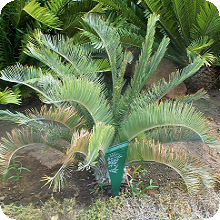|
| Division: Cycadophyta |
| Class: Cycadopsida |
| Order: Cycadales |
| Family: Zamiaceae |
| Genus: Encephalartos |
| Species: E. ngoyanus |
Conservation Status: |

E. ngoyanus
Ngoye Dwarf CycadEncephalartos ngoyanus, the Ngoye dwarf cycad, is a cycad growing to 1 m in height. The species has two discrete distribution areas, one in KwaZulu-Natal, the other in Swaziland and southern Mozambique. The habitat is grassland, often among rocks and forest margins, particularly the Ngoye forest for which the species has been named. Rainfall in this region is high, from 750 mm to 1000 mm per annum.
Veld fires stimulate coning in the plants, but too frequent fires have brought threat to the species, as does illegal plant collecting. E. ngoyanus is rare and considered vulnerable in its habitat in the twenty first century. This species has a comparatively slow reproduction rate among the cycad species.
It has an underground stem of about 30 cm long as well as tuberous roots, but no multiplying of stems from suckering. The stiffly erect leaves become from 60 cm to 1,25 m long with straight green rachises. Both the petiole (the leaf stalk below the lowermost leaflets) and rachis (the sturdy leaf axis from which the leaflets grow) are grey woolly. The petioles are about 15 cm long. The pale to dark green leaflets are ribbon-shaped (lorate) with entire margins or with one to three teeth.
Leaflets are well-spaced rendering them non-overlapping and orderly arranged along the rachis. The leaflets are woolly hairy when young, but later only upon their lower surfaces. Leaflets are 7 cm to 10 cm long and 8 mm wide. The leaves are softer and more flexible than those of E. caffer, the plant’s closest resembling relative.
Single cones are grown, dark yellow to pale brown in colour. Cones growing in shade tend to be olive green, not managing the yellow colouring. The seeds are red.
Cultivation:
E. ngoyanus grows well in cultivation but is not a vigorous grower and seldom has more than 8 to 10 leaves in a crown. It is often deciduous before new leaves or cones emerge. It prefers slightly dry conditions and should be grown in full sun. In its habitat they are found growing on steep slopes between boulders indicating its need for good drainage. Seedlings are very prone to damping off and should not be over watered.
It is semi hardy to frost and will often lose its leaves particularly on the Highveld. Such dormancy is normal and plants should not be watered when the leaves turn yellow in the autumn. Propagation is by seed only.
| semi-shade | green | low watering | slow growth | frost-resistant | uncommon |
E. ngoyanus grows well in cultivation but is not a vigorous grower and seldom has more than 8 to 10 leaves in a crown. It is often deciduous before new leaves or cones emerge. It prefers slightly dry conditions and should be grown in full sun. In its habitat they are found growing on steep slopes between boulders indicating its need for good drainage. Seedlings are very prone to damping off and should not be over watered.
It is semi hardy to frost and will often lose its leaves particularly on the Highveld. Such dormancy is normal and plants should not be watered when the leaves turn yellow in the autumn. Propagation is by seed only.
E. ngoyanus for sale at AfricaCycads.com:
